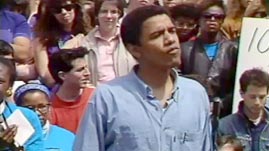Teachers' Domain - Digital Media for the Classroom and Professional Development
User: Preview

Source: WGBH: "The Ten O'Clock News"
This archival news footage from 1991 shows scenes from a rally held at Harvard Law School at which Barack Obama, a law student at the time and president of the Harvard Law Review, introduces Professor Derrick Bell. Some of the banners in the background read “Harvard Law School on Strike for Diversity,” “Diversity Now,” and “No More Excuses.” In his speech, Professor Bell notes the significance of his appointment two decades earlier as the first tenured African American professor, before chiding the school for its overall “past racist hiring record.”
This video is primary source footage and has not been extensively edited.
In the spring of 1991, Derrick Bell, a tenured African American professor at Harvard Law School, announced he was taking an unpaid leave of absence. He did this to protest Harvard’s decision to deny tenure to Regina Austin, a female African American visiting professor. At the time, no female African American had ever held a tenured teaching position at the school; Professor Bell considered this unacceptable, considering Harvard’s long history and its stature. It would be another seven years before Lani Guinier became the first African American woman awarded tenure.
During his career, Derrick Bell broke racial barriers and influenced students, including a young Barack Obama. He died in October 2011. The clip shows Obama introducing Bell at a campus demonstration in the spring of 1991, which was Obama’s final year at Harvard Law School. Obama encourages the crowd to “open up your hearts and your minds to the words of Professor Derrick Bell” and then embraces him.
Even before the 1991 protest, Bell had built a reputation as someone willing to sacrifice his position for a principle he believed in. At Harvard, Bell intended to shine a spotlight on affirmative action, a policy instituted in government and educational settings. Born of the civil rights movement and designed to ensure diversity and to make up for centuries of exclusion, affirmative action refers to steps taken to increase the representation of minority groups and women in employment, education, and business. Institutions with affirmative action policies generally set goals and timetables for increased diversity and use targeted recruitment and an element of preference—that is, favoring a qualified minority candidate over an equally qualified nonminority candidate—to achieve those goals and compensate for what Bell referred to as a “racist hiring record.”
Affirmative action was created to take discrimination based on race, religion, or gender out of hiring decisions and academic admissions and promote “equal opportunity.” Affirmative action decisions are not supposed to favor candidates who lack important qualifications. Much of the justification for affirmative action in other arenas, such as the workplace, has concerned righting past wrongs that have left minorities and women working in vastly lower-paying jobs and still discriminated against in some sectors today.
Public opinion polls suggest that most Americans support affirmative action, especially when given a choice between affirmative action as it currently exists and no affirmative action at all. However, not everyone is in favor of it. For example, opponents of affirmative action think preferential treatment leads to some minorities and women gaining admission to college or being hired regardless of their academic or job merit. They may also blame the policy for encouraging “reverse discrimination” against white males in particular, robbing them of promotions and other opportunities.
Here are suggested ways to engage students with this video and with activities related to this topic.
 Loading Standards
Loading Standards